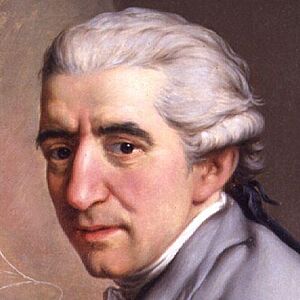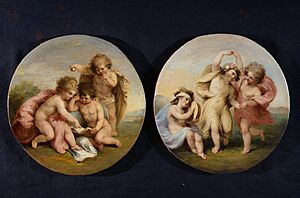Giovanni Battista Cipriani facts for kids
Quick facts for kids
Giovanni Battista Cipriani
|
|
|---|---|

from a larger painting by John Francis Rigaud.
|
|
| Born | 1727 Florence, Italy
|
| Died | 14 December 1785 (aged 57–58) Hammersmith, England
|
| Nationality | Italian |
| Known for | painting |
Giovanni Battista Cipriani (1727 – 14 December 1785) was a talented Italian painter and engraver. An engraver is an artist who creates designs on metal plates, which can then be used to print pictures. Cipriani moved to England in 1755 and spent most of his life there. Some people also called him Giuseppe Cipriani. He often created drawings for prints, and his friend Francesco Bartolozzi would engrave many of them.
Contents
Early Life and Art Training
Giovanni Battista Cipriani was born in Florence, Italy, in 1727. His family came from a nearby town called Pistoia. He began his art studies with Ignazio Hugford, an artist from Florence with English family roots. Later, he learned from another artist named Anton Domenico Gabbiani.
From 1750 to 1753, Cipriani lived in Rome. There, he met two important people: Sir William Chambers, a famous architect, and Joseph Wilton, a sculptor. In August 1755, Cipriani traveled with them to England.
Before moving to England, Cipriani had already painted some important artworks in Italy. He created two paintings for an abbey in Pistoia, which made him quite well-known. He also painted a large canvas for the organ in a church in Florence and the main altarpiece for another church.
Painting for Important People
When Cipriani arrived in England, he quickly found many important people who wanted to support his art. These included Lord Tilney and the Duke of Richmond.
His friend, Sir William Chambers, designed a building in London called the Albany. Cipriani was asked to paint a beautiful ceiling there. He also painted a part of a ceiling at Buckingham Palace, which is now a famous royal residence. Another project was decorating a room with scenes from poems at a place called Standlynch in Wiltshire.
Art at Somerset House
Cipriani also helped decorate Somerset House, another grand building designed by his friend Chambers. He created many artworks for the inside of the north part of the building. This included the rooms where the Royal Academy of Arts moved in 1750. Today, these rooms are part of the Courtauld Gallery.
In the Royal Academy's waiting room, the main painting was done by Sir Joshua Reynolds. However, Cipriani painted the four smaller sections around it. These sections showed ideas like Allegory (symbolic art), Fable (stories), Nature, and History. In the same building, he also painted black and white decorations in a shared waiting room for the Royal and Antiquarian Societies.
Cipriani was very involved in the look of Somerset House. Many of the carvings on the outside of the building were based on his detailed drawings. These carvings included decorative masks above doorways and other artistic groups. Many of these were carved by the sculptor Joseph Nollekens.
Royal Academy and Other Works

In 1768, Cipriani became one of the founding members of the Royal Academy of Arts. He designed the special diploma that new members received, and his friend Francesco Bartolozzi engraved it. To thank him for his work, the members gave him a silver cup in 1769.
Cipriani was also popular with publishers. He made many pen-and-ink drawings, sometimes colored, for books and prints. Bartolozzi engraved most of these drawings. Cipriani also created some of his own engravings, including "The Death of Cleopatra" and "The Descent of the Holy Ghost."
He designed allegorical (symbolic) pictures for the famous Gold State Coach, which is used by the British monarch, and the Lord Mayor's Gold Coach. He also helped repair old paintings by famous artists like Verrio at Windsor Castle and Peter Paul Rubens at the Banqueting House in Whitehall.
Furniture Decoration
Cipriani also used his artistic skills to decorate furniture. He designed many groups of nymphs (mythical female spirits) and amorini (small winged angels, like Cupid). These designs were often used as central decorations on furniture, especially the elegant satin-wood pieces that became very popular in the late 1700s.
Sometimes, these designs were inlaid into the wood using different colored woods (a technique called marquetry). More often, other artists painted Cipriani's designs directly onto the furniture. Some furniture designed by the famous Adams brothers was likely painted by Cipriani himself. He even designed handles for drawers and doors!
Later Life and Legacy
Giovanni Battista Cipriani passed away in Hammersmith, west London, on December 14, 1785. He was buried in Dovehouse Green, Chelsea, where his friend Bartolozzi put up a monument to remember him. Cipriani had married an Englishwoman and had two sons.
Several artists learned from Cipriani, including John Alexander Gresse, Charles Grignion the Younger, and Mauritius Lowe. His work helped shape the artistic style of his time, especially in decorative arts and printmaking.
Images for kids
-
from a larger painting by John Francis Rigaud.
-
Pair of Tondos with Putti. Oil on canvas, 26,5 cm diameter each. Collezione M (private collection) Rome.



